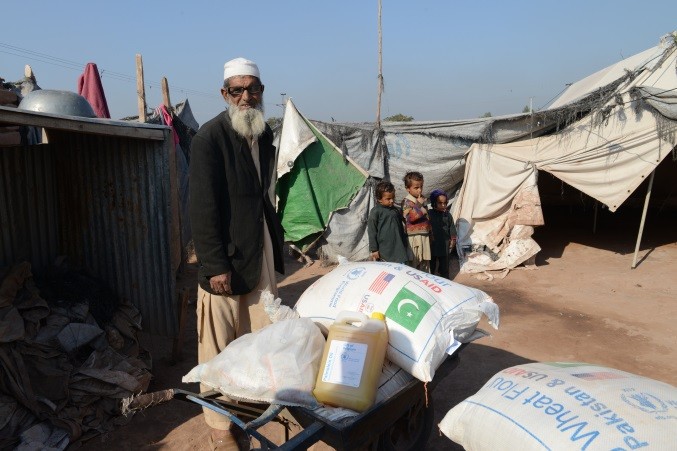
The Federally Administered Tribal Areas (FATA) and Khyber Pakhtunkhwa Province (KP) of Pakistan have been plagued by complex cycles of violence and military activities since 2008. The initial insecurity led to the mass displacement of more than 3 million, and while many have since returned to their homes, 1 million internally displaced persons (IDPs) still remain separated from their homeland.
This displacement has caused severe disruption to the food security of these individuals and significant losses of productive assets.
Khan Faqir, a subsistence farmer from Khyber Agency in FATA, is just one of the many displaced. Unable to return home since 2010 and with little opportunity to work and earn a living, Faqir has relied on food assistance to help feed his family of nine.
“The situation in our area was really bad due to militancy,” said Faqir. “We had no money when we arrived at the camp. I was a farmer with some land and a regular income back at home. Now that is all destroyed and I am living in the camp with my family.”
Since 2009, USAID has contributed over $340 million to the U.N. World Food Program (WFP) to help feed those displaced by violence in the FATA and KP regions. This funding has been used to buy and ship food from the United States as well as to purchase locally and regionally produced commodities, including rice, vegetable oil and ready-to-use therapeutic foods to address malnutrition.
U.S. funding has also supported market-based interventions by providing cash transfers and food vouchers to select displaced populations so they can purchase foods from their local markets.
In 2013, recognizing that the food security of those displaced by conflict in KP and FATA was continuing to deteriorate, the Government of Pakistan announced that it would donate 150,000 tons of wheat, valued at $53 million, to the WFP’s operations in the two regions.
With this “in kind” gift from the government in hand, WFP then turned to other donors for funds to support the costs of “twinning” the donation, that is, pairing the Government of Pakistan's food donation with resources from other donors to cover the costs of milling, fortifying, storing, and distributing wheat and wheat flour. USAID, along with donor agencies of Australia, the United Kingdom and Belgium, as well as the U.N. Central Emergency Response Fund, pledged to meet WFP’s request.
Because of the new flexibility in USAID food assistance programming, USAID’s Office of Food for Peace was able to respond to this request with a contribution of $7 million in September 2013. The USAID/Pakistan mission contributed $8 million, bringing the total support from the U.S. Government to $15 million, or enough to mill and distribute over 50,000 tons of the Pakistan wheat.
In comparison, had USAID purchased and shipped 50,000 tons of wheat from the United States to Pakistan, it would have cost the U.S. Government approximately $39.3 million, based on 2013 wheat prices. In this case, having cash resources readily available for food assistance allowed USAID to leverage the resources of others, demonstrate partnership with the host government, and provide the food for $24.3 million less than shouldering the full burden of buying and shipping the same tonnage from the United States.
Faqir is now one of the many IDPs benefitting from this latest assistance, having received the wheat flour as part of a larger ration including cooking oil, pulses and biscuits.
“We survived the initial few days on the little food that we had brought with us, but then we were registered,” he said. “We are really thankful to those who are providing us this ration in this hour of need.”







Comment
Make a general inquiry or suggest an improvement.